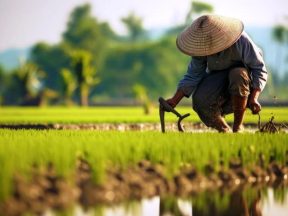Economy. Dynamic Development.
The country is extremely rich in water resources and minerals. The latter have featured largely in its economy.
On the contrary, the agricultural sector occupies a secondary position but, despite this, it employs as much as 37% of the workforce, a much higher percentage than the industrial sector which absorbs about 14,3%. These figures show that the economy of Azerbaijan leans greatly towards agriculture. The other sectors and services, still underdeveloped, employ 48% of the entire workforce of the country. It must also be noted that there is a high degree of growth in the production of energy from alternative sources rather than fossil fuels by using the many water-courses present in the country, the largest of which have been dammed for hydroelectric installations.
Since independence, the country has seen various economic phases. Immediately after independence, there was a decline for various reasons among which were the acute phase of the conflict with Armenia, the lack of government experience, the deterioration of the productive sectors, the break in relations with the traditional markets of the former Soviet republics, and the end to financing from Moscow.
Nevertheless, since the early years of the new millennium, there has been a notable inversion of trends that enabled the country to achieve a dynamic phase of development mainly due to development in the petroleum sector. All of this was due also to the results produced by creating new road infrastructure, the agricultural reform granting the lands to farmers and the development of private farms, but most of all to the effects produced by the energy policy followed by the State and the famous ‘contract of the century’.
This accord was signed in ’94 by the then President with as many as eleven large oil companies from various countries, thus offering Azerbaijan the opportunity to integrate internationally.
The new energy policy established that 20% of national hydrocarbons was, or is, managed by the State company SOCAR, while the remaining 80% of production is managed by means of a series of commercial development agreements by British Petroleum and by an Azerbaijani consortium which included the foreign companies (AIOC).
This has favoured an enormous influx of foreign capital which has generated exponential growth in the Azerbaijani economy with a relative increase in the number of employed, an improvement in local infrastructure and annual average growth in GDP of 10% during the decade from 1996 to 2005.
Of importance in the strengthening of the economy of the country has been the export of oil using the newly built pipelines Baku-Novorossiysk and Baku-Supsa, completed respectively in 1996 and 1999.
In those years, a contract was also signed for pipelines linking Baku-Tibilisi-Ceyan (Btc) and Baku-Tibilisi-Erzurum (Bte), greatly desired by the Americans and British since the nineties when NATO was revisiting its geopolitical orientation to allow the country to diversify its routes to other countries independently of Moscow. Those years also saw the construction of new schools, hospitals, sporting facilities, social and communications structures (some are still under construction) among which the rail and motorway link between Baku, Tbilisi and Kars, the new port of Alat for maritime commerce, as well as advanced naval shipyards, also in the province of Alat, as well as the construction of the new Baku airport. The main objective of the new infrastructure development is to exploit the geographical position of the country to create a hub in the transport sector with logistical centres connected to the main international supply chains in both directions: north-south (within the Caucasus and the macro Asiatic region) and east-west (mainly reinforcing links with the West) and therefore an important crossroads of exchange between Europe and Asia.
The finance for the development works of the country comes through the State Oil Fund of Azerbaijan which allocates the economic surplus from oil exports. However, the country has never moved towards real economic diversification, and this produced tremendous growth of around 28% per annum when the price of crude was over $100 a barrel, and also great hardship when, in 2016, it fell to $30 a barrel and the Manat lost 30% of its value.
The pandemic, together with the conflict with Armenia that broke out again in 2020, the collapse in the price of crude and consequently of fiscal income, further damaged the Azerbaijan economy which is paying the price for the lack of diversification and is now aiming energetically to develop the logistics sector by creating new transport structures, technological parks, solar electricity centres and wind farms, as well as the development of the agricultural and tourism sectors. Ambitious projects are also to be found in the ‘Baku City Master Plan 2040’, to convert the capital into a Smart City.
It is also worth noting that, following the ceasefire with Armenia, greater public investments in infrastructure have been assigned to the so-called ‘liberated territories’, now under Baku control, for their reconstruction, among which is a new railway expected to connect Azerbaijan to its former enclave of Nakhchivan. (F.R.)






